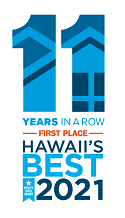The neighborhood of Kakaako is thriving - with plans for dozens of new condominiums, retail outlets and restaurants in the near future. However, some local consumers look at the condo prices and think, "No way! I can't afford that." But what if you qualified for a lower price?
We hear terms like "reserve housing" and "workforce housing,” but what does that really mean to the consumer? One of the great things about Kakaako is that there is diversity in the types of units offered. You may look at a condo and think it's out of your price range, but within each building there may be units set aside that are within your reach.
So what are the different housing types and which one works best for me?

Market Housing
The sticker price is what you pay - sort of. There are fewer restrictions set in place regarding income and personal assets, but there’s always room for negotiation, right?
Workforce Housing
Your combined annual household income has to be between 100-140% of the area's median income. In Honolulu, that's $82,600-$115,640.
Reserve Housing
Your combined annual household income cannot exceed 140% of the area's median income. In Honolulu, that means $115,640 per year or less.
Affordable Housing
You qualify if your combined annual household is under 100% of the area's median income. In Honolulu, that means $82,600 per year or less. Read more about affordable housing.
However, this is just the tip of the iceberg. There are several other factors that determine whether or not you qualify for workforce, reserve and affordable housing. To find out if you're eligible, it’s best to discuss your housing options with your real estate agent so you are prepared to win in the competitive real estate market.
See what Scott had to say about the different housing types on Hawaii News Now.
Congratulations, you have access to Hawaii's most comprehensive Real Estate Search! Please help us to better serve you by answering these optional questions.
Facebook Registration
This email is already registered. Click the button below and we'll send you a link to reset your password.
You have already registered using your FB account.
Check your inbox for an email from brokersmls@locationshawaii.com. It contains a link to reset your password.
The agent who gave you access to this website is no longer with Locations LLC.
Due to local MLS regulations, you will need to re-register if you would like to continue your access.
We will pre-fill the registration form with information in our files. Once you click Register you can either select a new agent or one will be assigned for you.
Sorry for the inconvenience, Locations LLC.
Schedule a Virtual Tour
Request an appointment to view this property by completing the information below. Please note your appointment is not confirmed until an agent calls you.
Disclaimer: The properties we may show you may be Locations LLC listings or listings of other brokerage firms. Professional protocol requires agent to set up an appointment with the listings agent to show a property. Locations, LLC may only show properties marked "Active" and "ACS".
Listings in
Additional Criteria
Keep your eye on this property! Save this listing and receive e-mail updates if the status of the property changes.
Share this property by completing the the form below. Your friend will receive an e-mail from you with a link to view the details of this property.
How can we help?
Send a message and we'll respond shortly.
We will not rent, share, or sell your information. Privacy Policy.











